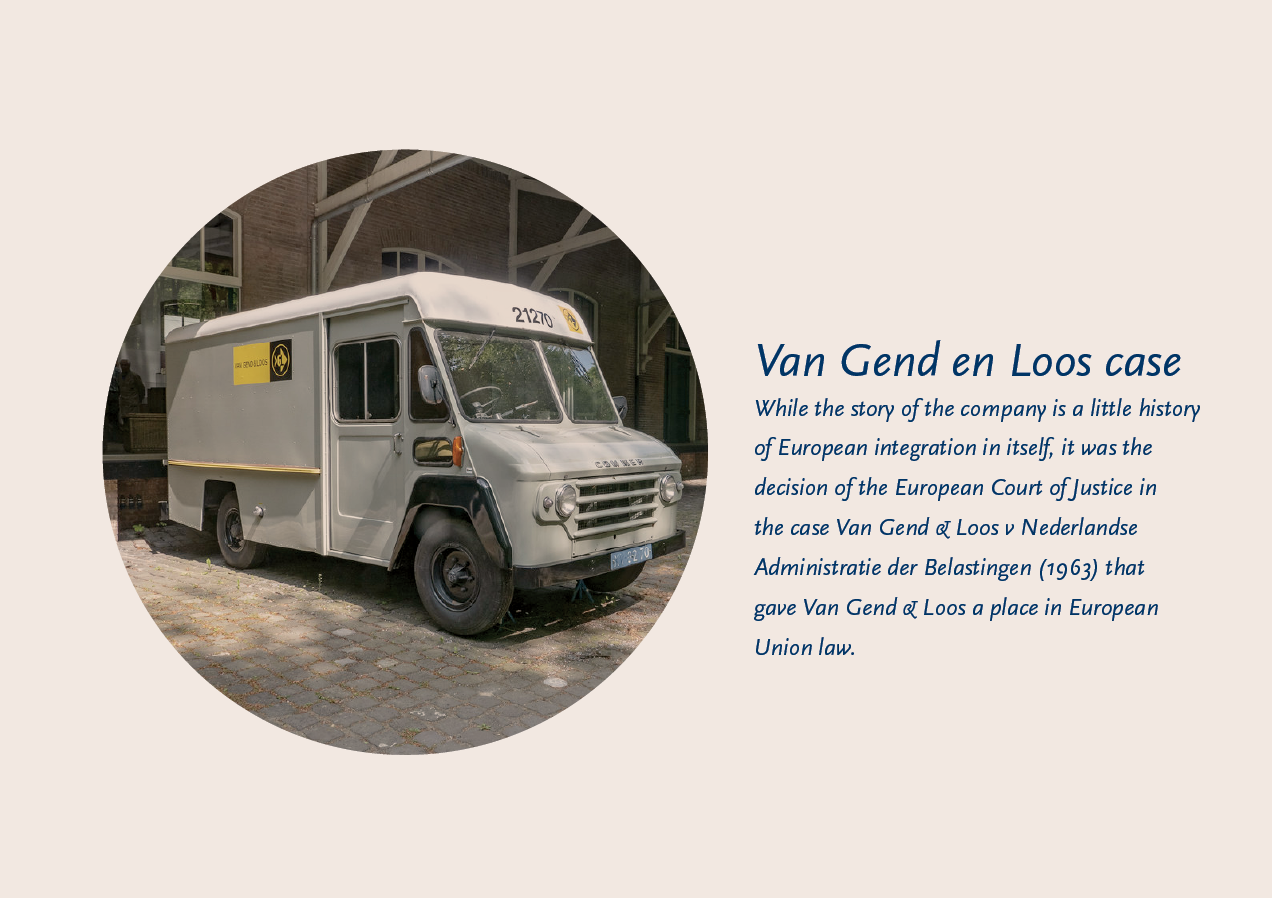Van Gend en Loos case

While the story of the company is a little history of European integration in itself, it was the decision of the European Court of Justice in the case Van Gend & Loos v Nederlandse Administratie der Belastingen (1963) that gave Van Gend & Loos a place in European Union law. The case itself was rather dull, but the stakes were high and the core issue was, so the story goes, existential to the future of European integration.
The company Van Gend & Loos was established in 1809 when the Antwerp-based carriage driver Jan-Baptist van Gend, married to Maria Loos in 1796, merged his diligence company with the Loos family business. The Van Gend & Loos company gradually extended its network of diligence services to transport passengers, goods and money. It continued its activities in both countries also after Belgium became independent from the Netherlands in 1830, and later expanded beyond the low countries. The company was reorganised several times, when transport changed from carriages to trains, and later to vans and trucks. Van Gend & Loos -no longer a family business from 1885 onwards- became synonymous for package services. After several reorganisations and take-overs, the name Van Gend & Loos finally disappeared from the vans, trucks and warehouses in 2003, when several distribution companies, then owned by Deutsche Post, merged to DHL.
The judgment – usually mentioned in one breath with its Italian twin Flaminio Costa v ENEL - is known as one of the landmark decisions that made the EU what it is today, with EU lawyers claiming that the EU may not even have survived without them. The Court of Justice itself celebrated the anniversary of the decision with a festive event in 2013.
Van Gend & Loos stands for the proposition that the European Union (or European Economic Community as it was known then) is ‘a new legal order’, different from ‘ordinary institutional organisations’ in that the laws of the European Union are part of the law of the land of each of the member states, for national judges to enforce (Van Gend & Loos), even when national authorities try to deviate from them (Costa v ENEL).
The decision made it clear that EU law can entitle citizens and companies directly, that they can go to their own courts to vindicate their rights deriving from EU law and that national courts should not wait for national legislatures to transpose those rights in national law. Among lawyers, this is known as the doctrine of direct effect.
The case itself emerged from a rather technical dispute over the classification of ‘Harnstoffharz’, a substance used usually used as a glue for wooden doors, that Van Gend & Loos imported from Germany into the Netherlands. The Dutch Government had changed the classification of the substance, and as a consequence the duties due for the import of the substance increased. Van Gend & Loos claimed that with the increase, the Dutch government infringed the agreement made between the Member States in the European Treaties not to increase import duties. But did that agreement only concern Member States and was it only for the Commission to enforce it? Or could a company claim the right to oppose such increase before the Dutch court against its own government?
Thanks to the preliminary ruling procedure the Dutch court hearing the case -uncertain as to the answer to the question on the basis of Dutch law- could ask the Court of Justice to rule on the question for the whole of the European Union. The director of the Legal Service of the Commission, the Frenchman Michel Gaudet, immediately understood the importance of the issue for the future of Europe, as he saw an important role for law and courts in the establishment of the common market. He tried to convince the Court to rule in favour of the rights of individuals and companies and to make the European Union a community based on law rather than government power.
We will never really know what happened during the délibéré: that mystery is safely kept in Luxembourg. But archival research does indicate that the Court was divided on the issue. In the end, following the lead of judges Lecourt and Trabucchi, a majority of 4-3 decided not to follow the advice of Advocate General Roemer, and found in favour of the ‘new legal order’ and the ‘direct effect’ of Article 12 EEC. Two years later, the Court of Justice completed the ‘new legal order’ in its Costa v ENEL decision, introducing the primacy of EU law. To this day, lawyers and historians disagree on whether and to what extent the decision was revolutionary and even an act of judicial activism, or rather followed from the Treaties and the system as it was designed and intended.
Even though the company Van Gend & Loos no longer exists, Article 12 EEC has been deleted from the Treaties, and import duties have been abolished in the internal market, Van Gend & Loos has not lost its relevance today. It lives on in the common imaginary of EU lawyers as the landmark decision introducing the notion of the new legal order integrated in the legal orders of the Member States and granting rights directly to individuals and companies.
| More blogs on Law Blogs Maastricht |
Other blogs:
Also read
-
-
Throughout the EU, the rights of asylum seekers come under pressure. Overdue policy changes remain stuck in negotiations because of lacking political will. It is up to the European Commission to step up and protect the fundamental rights of asylum seekers.
-
The horrendous military activities of Russia in Ukraine have caused a severe backlash from tech giants. YouTube clamped down on Kremlin-backed channels for spreading war propaganda. Meta allowed its users to wish death to Russian armed forces. On top of that, Twitter is constantly policing tweets by...



